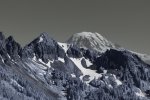tehfrr
New member
- Joined
- Feb 6, 2020
- Messages
- 10
- Points
- 1
Thank you for all the responses, appreciated.
I already have a 500mw 405nm laser, and it is not suitable, not even close. I definitely want 375nm - 240nm. Nothing lower as 240nm starts generating ozone gas. I want to keep this project relatively sane; Im comfortable with lasers and ultraviolet sources. Poison gas, not so much. Power level - 50mw-500mw. If it needs more than 500mw its time to rethink the whole thing.
The primary application is for reflected ultraviolet photography using a full spectrum converted camera. I have a UV pass filter (Baader U Venus) and the 405nm laser can barely be seen even close up with long exposures. Meanwhile my Convoy C8 flashlight lights things up with a filtered 365nm LED.
My primary uses for a handheld UV laser would be:
-Placing a dot on something a ways off to focus the camera at night. The optics are not made for UV, so there is a focus shift from visible.
-Putting a short but intense burst of UV on plants and non-living objects to induce fluorescence and photograph with a UV cut filter
-Attaching a beam expander and using it similar to an IR laser designator/illuminator
-Rockhounding - looking for fluorescent minerals without needing to be right up on them
Ive successfully done all of these (except for rockhounding) in infrared with a 300mw 808nm laser.
(Edit-grammar)
I already have a 500mw 405nm laser, and it is not suitable, not even close. I definitely want 375nm - 240nm. Nothing lower as 240nm starts generating ozone gas. I want to keep this project relatively sane; Im comfortable with lasers and ultraviolet sources. Poison gas, not so much. Power level - 50mw-500mw. If it needs more than 500mw its time to rethink the whole thing.
The primary application is for reflected ultraviolet photography using a full spectrum converted camera. I have a UV pass filter (Baader U Venus) and the 405nm laser can barely be seen even close up with long exposures. Meanwhile my Convoy C8 flashlight lights things up with a filtered 365nm LED.
My primary uses for a handheld UV laser would be:
-Placing a dot on something a ways off to focus the camera at night. The optics are not made for UV, so there is a focus shift from visible.
-Putting a short but intense burst of UV on plants and non-living objects to induce fluorescence and photograph with a UV cut filter
-Attaching a beam expander and using it similar to an IR laser designator/illuminator
-Rockhounding - looking for fluorescent minerals without needing to be right up on them
Ive successfully done all of these (except for rockhounding) in infrared with a 300mw 808nm laser.
(Edit-grammar)
Last edited:









